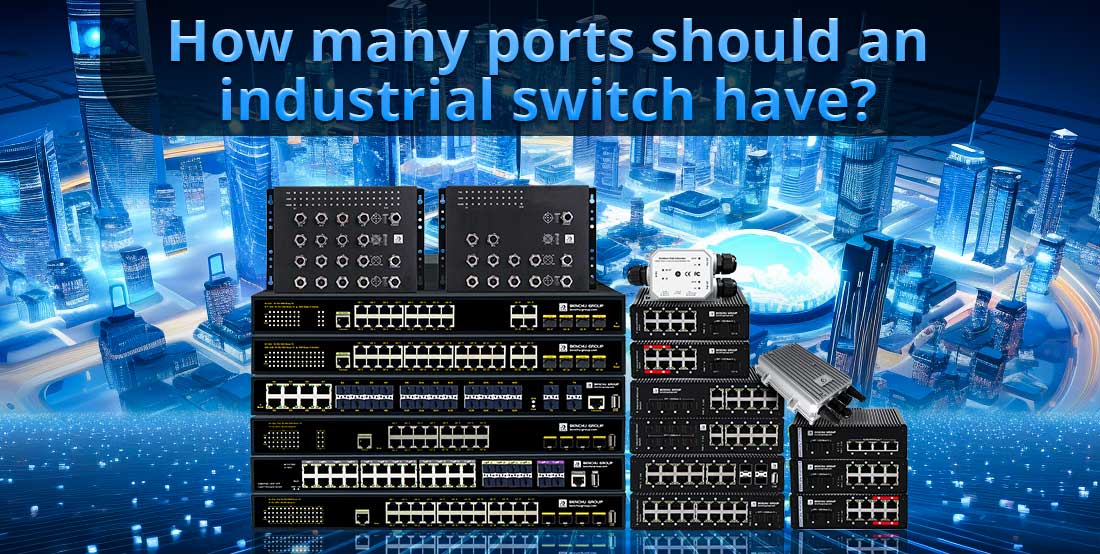
The number of ports on an industrial switch depends largely on the specific requirements of the application, the size of the network, and the devices connected to it. However, industrial switches generally have a wider range of port counts than typical office or home switches due to the diverse and complex nature of industrial environments.Here’s a detailed breakdown:
1. Types of Ports
Ethernet Ports: Standard Ethernet ports are the most common and are used for connecting various devices such as sensors, controllers, and other switches.
Fiber Ports: Fiber optic ports are used in environments where high-speed data transfer over long distances is essential. These ports are particularly useful in electrically noisy environments or where signal degradation could be an issue.
Power over Ethernet (PoE) Ports: These ports provide both data and electrical power to devices like IP cameras, wireless access points, and other networked equipment without needing separate power cables.
2. Factors Affecting the Number of Ports
Network Size: Larger networks require more ports to accommodate all connected devices. Industrial switches can range from 4 ports to as many as 48 ports or more, depending on the application.
Device Count: In industrial settings, you may need to connect several devices such as programmable logic controllers (PLCs), human-machine interfaces (HMIs), cameras, sensors, and more. The more devices, the more ports needed.
Redundancy Requirements: In many industrial settings, redundancy is crucial for ensuring high reliability and uptime. You may need extra ports to implement redundant network paths.
Future Expansion: It’s common to plan for additional devices that will be added to the network in the future. Choosing a switch with more ports than immediately necessary can save time and money by avoiding the need for future upgrades.
Port Speed: Industrial switches often come with a mix of Fast Ethernet (10/100 Mbps) and Gigabit Ethernet (10/100/1000 Mbps) ports. Some switches may even support 10GbE ports for applications requiring very high throughput.
3. Common Port Configurations
Small Networks or Edge Applications: A 4- to 8-port switch might be sufficient for small networks, such as those connecting sensors and controllers in a localized area or on the edge of the network.
Medium-Sized Networks: A switch with 8 to 24 ports may be suitable for connecting multiple devices in a more complex industrial setup. This is common in manufacturing lines, monitoring systems, or warehouse automation.
Large Networks: For large-scale operations, such as those in energy, utilities, or smart city infrastructure, a switch with 24, 48, or even more ports might be necessary. These switches are typically used as distribution or core switches in a hierarchical network design.
4. Specialized Industrial Requirements
Harsh Environments: Industrial switches often operate in extreme conditions such as high temperatures, dust, vibration, or humidity. In such cases, the number of ports needed could also depend on the available space and power considerations.
Network Segmentation: In some industrial networks, it’s important to segment traffic between different types of equipment for security and performance reasons. This can increase the number of required ports for creating separate VLANs or virtual networks.
5. Modular vs. Fixed Configuration
Modular Switches: These switches allow users to add or remove port modules as needed, providing flexibility for expanding the network over time.
Fixed-Port Switches: These switches come with a set number of ports and cannot be expanded. They are typically more cost-effective but less flexible for future expansion.
Summary of Recommendations
For Small Applications: 4-8 port switches are typically enough.
For Medium Applications: 8-24 port switches provide a good balance between current needs and future growth.
For Large Applications: 24-48 or more ports are ideal for core networks or large-scale industrial systems requiring high performance and redundancy.
By carefully assessing the number of devices in the network, expected data traffic, and future growth plans, the right industrial switch with the appropriate number of ports can ensure both efficient operations and flexibility for expansion.